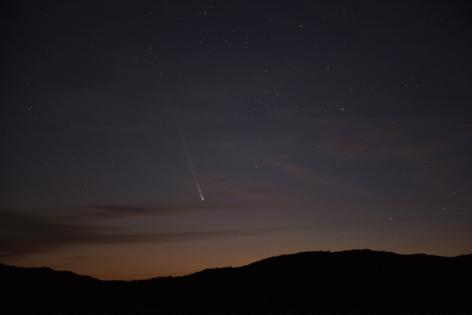Rare comet will be visible to the naked eye Saturday in California
Published in Science & Technology News
Stargazers will have the opportunity of a lifetime Saturday: the chance to view a newly discovered comet with the naked eye.
The visitor — an ancient dirty snowball from the Oort Cloud — was discovered last year by astronomers in China and South Africa as it approached the inner solar system, NASA said in a news release. And this truly is your only chance to see it; NASA said the comet, dubbed C/2023 A3 Tsuchinshan-ATLAS, isn't expected to come within viewing distance again for 80,000 years.
And what, you ask, is the Oort Cloud? Scientists describe it as a giant spherical shell around our solar system made of icy, comet-like objects.
NASA officials said the comet made its closest transit past the sun on Sept. 27 and is on track to come within approximately 44 million miles of Earth on Saturday. Given its orbital path, the last time this comet would have been seen in the sky was about 80,000 years ago, during the time of the Neanderthals.
The comet will look like a bright fireball with a long, extended tail, said Bill Cooke, lead of NASA's Meteoroid Environment Office at the Marshall Space Flight Center in Alabama, KABC-TV reported.
The exact intensity of Tsuchinshan-ATLAS's brightness is tough to predict; the comet is still light-years away from Earth, after all.
Unlike a meteor that appears to zoom across the sky, Cooke told KABC, C/2023 A3 Tsuchinshan-ATLAS will appear to hang in space and slowly change position from night to night until it recedes from view in early November.
To view the comet, NASA officials recommended people choose a dark vantage point away from light pollution about 45 minutes after sunset. A pair of binoculars will enhance your view of the comet, but you should be able to spot it without them.
To locate C/2023 A3 Tsuchinshan-ATLAS, face southwest and look roughly 10 degrees above the horizon to find the constellations Sagittarius and Scorpio. The comet should be visible between them. In addition, mobile apps such as SkySafari 7 and Night Sky enable users to locate celestial objects simply by pointing their phones at the sky.
_____
©2024 Los Angeles Times. Visit latimes.com. Distributed by Tribune Content Agency, LLC.







Comments